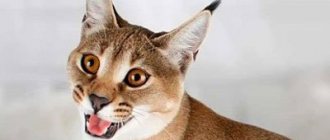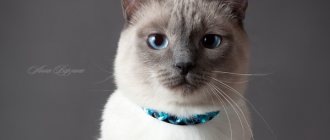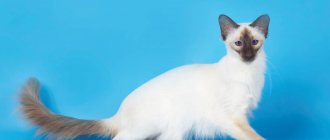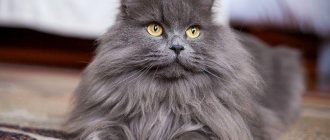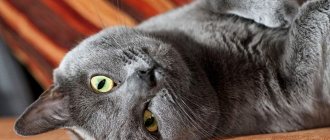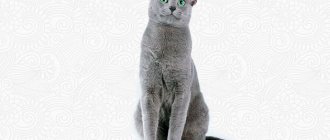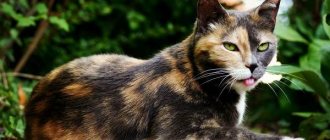Highlanders are large domestic cats with short tails and folded back ears. Their lynx-like appearance will appeal to connoisseurs of wild beauty. And since Highlanders are bred mainly in the USA and Australia, it is advisable to better study the main features of the breed before purchasing them.
Brief history of the breed
Work on breeding Highlanders began in 1993, when breeders decided to improve the already existing Desert Lynx cat variety. To make their ears curled, experts used representatives of the new hybrid breed Jungle Curl (obtained by crossing Bengals, Serengeti, Egyptian Mau, American Curls, Chausie, etc.).
As a result, the breeders managed to fix the folded ears while maintaining the spotted lynx coloring. In May 2008, the Highlander cat breed received recognition from TICA, and since 2016 it can be exhibited in the Advanced new breed class.
Read more - “About different breeds of cats with curled ears.”
Interesting Facts
Although the Highlanders do not have a rich history, many interesting things have been associated with them:
- The name of the breed Highland Lynx translates as “mountain lynx”. And in some sources these cats are referred to as shorthaired Highlanders.
- Due to the similar name, representatives of the breed are often confused with Highland Folds. But they are in no way related to the British and Scottish Longhairs.
- Formally, Highland Links can be considered hybrids. But the percentage of wild blood present in them is so small that it does not affect anything at all. Therefore, genetically, Highlanders are completely domestic cats that do not pose a threat to people.
History and breed standard
The breed was developed only 10 years ago. American breeders were faced with the task of creating a cat that looked like a wild lynx. The breed was taken as the “mountain lynx” (Highland Lynx). In fact, it has nothing to do with wild animals, just as it does not have wild genes in its genus.
I must say that the experiment was a great success. The result was a small domestic lynx, but absolutely domestic, affectionate and completely non-aggressive.
The breed received its own name in 2004. In the same year it was officially recognized and received its standard. Since 2008 he has been successfully participating in exhibitions.
Breed description, standards, appearance
Highlanders are muscular, compact cats with short tails and ears turned outward. Outwardly, they resemble strong and agile lynxes.
Dimensions and weight
Highlanders are fairly large cats with pronounced sexual dimorphism. The average weight of a female is 4.5-6.5 kg. The weight of a male Highland Lynx varies between 6.5-9 kg.
Anatomical characteristics
A typical Highlander cat should fit the following description:
- The head is triangular, with rounded cheekbones, a convex skull, a high forehead, a short blunt muzzle, pronounced whisker pads and a wide nose.
- The eyes are almond-shaped, medium-sized, slanting, widely set. The iris of the Highland Lynx can be green, orange or yellow.
- The ears are medium in size, with a wide base and flexible, curved back tips.
- The body is rectangular in shape, with a straight back, slightly raised croup and well-developed muscles.
- The limbs are of medium length, with rounded paws and pronounced knuckles.
- The tail is thick and short. Its length in Highland Links should not be less than 2.5 cm and longer than the hock joints.
On a note. The Highlander is one of the few breeds in which polydactyly is acceptable.
Color and coat type
The body of the Highland Lynx is covered with beautiful fur, the texture of which depends on the length and color. A cat of this breed is:
- shorthair - with a thick coat and dense undercoat;
- long-haired - with developed decorative hair, which, as it were, forms trousers and a frill.
According to the Highland Lynx breed standard, spotted, marbled or striped tabbies in any color combination are allowed.
On a note. The color of the Highlander's coat is determined by the tone of the undercoat. For example, if a cat's fur appears to be silver-black and her underpads are brown, then her color would be considered brown.
Possible breed defects
Exterior defects, the presence of which reduces the breeding value of the Highland Links:
- weak bones;
- the tail is shorter than 2.5 cm and longer than the hocks;
- ears are bent more than 90 degrees.
Choosing a kitten
A purebred animal must be sold to a new owner with a ready-made passport.
The cat breed is considered unique and rare, therefore, when purchasing a pet that meets absolutely all standards, felinologists recommend paying attention to the following nuances:
- Purebred cats are bought only from breeders with a good reputation.
- Attention must be paid to behavioral differences. Apathetic, indifferent kittens, as a rule, do not feel well, and hostility and aggression indicate improper upbringing of the pet. It is better to refuse such cats.
- It is recommended to familiarize yourself with photographs of Highlander cats exhibited by the owner.
- Pedigree animals are given along with passports, health certificates from a veterinarian, and pedigree papers. These documents are needed for the cat to participate in competitions.
Character and temperament
The Highlander is a cat with a friendly and gentle disposition. He likes to be the center of everyone's attention, and he achieves this through funny pranks.
The curious Highland Lynx explores new places with the enthusiasm of a true explorer, but does not go on a “race” through curtains and closets.
On a note. Highlanders are not particularly talkative. To express emotions, representatives of the breed prefer to use tail wagging or an ingratiating look into the eyes of their owners.
The friendly nature of Highlanders allows them to easily find a common language with children. Non-jealous and calm cats never respond with aggression to childish pranks. Highland Links also easily get along with other pets and get along peacefully with all animals, including rodents, reptiles and birds.
Character
An adult Highlander is a cat with a sense of self-esteem. These are friendly pets who love their family but remain independent. They remain quietly alone. They don’t impose themselves when they see that people have no time for them. They do not have the habit of yelling out of boredom, marking or tearing up furniture to attract attention.
But still, the Highlander cat is more domestic than a yard cat. She needs contact with her family, active games, affection. The need for exercise is average after 3-5 years, but young Highlanders are playful, curious and active. This is not a sofa decoration - the cat will take part in the life of the family.
They love neat children and easily get along with harmless dogs. They are loyal to guests, but more often without much interest. Like Siberians or bobtails, Highlanders divide people into friends and foes. The hunting instinct is well expressed - you cannot leave them alone with birds, mice and other small animals.
The breed is not suitable for those who believe that a cat should obey. Your pet will easily learn the rules if you present them in a playful way with encouragement. To be forced to do anything involves a natural tendency to resist any restrictions, and this will quickly spoil a good-natured character.
How to choose the right kitten
The Highlander is an expensive and rare breed of cat. Leading breeders specializing in breeding such animals live in the United States. Therefore, you will most likely have to choose a Highland Lynx kitten in absentia. In this case, it is advisable to focus on the following criteria:
- availability of pedigree and veterinary passport;
- conditions of detention;
- behavioral characteristics;
- compliance with the breed standard;
- health status.
On a note. Highlander kittens are born straight-eared. As they grow, the tips of their ears curl back.
Care and maintenance
Unpretentious Highland Links are able to quickly adapt to any conditions. They live in apartments and private houses without any problems. Caring for Highlanders includes a number of standard procedures:
- The eyes and ears of cats are regularly examined for the presence of nonspecific discharge and wiped with cotton pads soaked in alcohol-free products.
- Highlanders' claws grow very quickly and break off. Therefore, they are systematically shortened with a nail cutter so as not to affect the blood vessels. And to prevent cats from tearing wallpaper and upholstered furniture, they are provided with scratching posts.
- Highlanders' teeth are brushed several times a week with a non-foaming paste using a special silicone brush or soft brush.
- Cats of this breed are bathed 3-4 times a year or as needed. Bath procedures are carried out in warm rooms where there are no drafts. And for washing they use special shampoos.
- Long-haired Highland Links require careful grooming. They are systematically combed out with a slicker brush or a brush with soft bristles. The hair of shorthaired Highlanders is treated several times a week with a special glove.
Feeding the cat
Highlanders are active cats with an excellent appetite. They happily eat both industrial and natural food. Therefore, when choosing a diet, you can be guided by your own preferences.
With an industrial type of nutrition, Highland Links buy premium or super-premium food with a complete, well-balanced composition. The following brands of drying are perfect for cats of this breed:
- Acana;
- Bosch;
- Brit Care;
- Pronature.
Important! Highlanders, whose diet is based on dry food, should have free access to fresh drinking water.
With a natural type of nutrition, the menu of cats of this breed should be dominated by protein foods in the form of raw chicken, turkey, lean beef or rabbit meat. Several times a week, meat can be replaced with boiled offal and ocean fish. It is also recommended to include porridge, quail eggs, fermented milk products and vegetables in the diet of Highland Links.
To maintain normal functioning of the gastrointestinal tract, fatty meat, river fish, bones, potatoes, milk, sausages, pickles, confectionery and any food from the owner's table are excluded from the menu of these cats.
On a note. With a natural diet, mineral supplements are introduced into the Highlanders’ diet twice a year, which are selected after consultation with a veterinarian.
How to feed and maintain it properly?
A person who is planning to buy a British Highlander cat should not forget that the pet will become a family member who will need some attention. Before bringing a kitten into the house, you need to make sure there are places for feeding and a toilet. It is best to purchase bowls and a tray in advance. There are special requirements for the filler; it must be of high quality. It is recommended to give preference to wood fillers, which perfectly neutralize unpleasant odors and reliably retain moisture.
Small kittens need toys and a separate sleeping place for a person. Accidents with young animals often occur due to the fault of people. By putting a pet to sleep next to you, an adult can accidentally injure the kitten.
It is recommended to raise a Highlander cat from an early age, otherwise the animal may imagine itself to be the most important thing in the house and will stop paying attention to prohibitions. A kitten in a new home is introduced to the rules almost immediately. The furry baby must understand what can and cannot be done. As for punishment, it must follow immediately after the offense, otherwise the animal simply will not understand its guilt.
This breed is large in size and does not complain of appetite. When feeding the British, you need to follow the developed standards and prevent your pets from overeating. Excess food leads to obesity, and as a result - to huge health problems.
When choosing dry food, preference should be given to super-premium brands; you can also diversify the menu with pates and canned food with similar labeling. If natural feeding is chosen, then it is necessary to remember about the addition of vitamin and mineral complexes and use meat products as a basis. The main rule that a Highlander cat owner must follow is not to mix feeding natural products and dry formulas. If there is a need to change the diet, it is done gradually. In addition to food, cats also need drinking water, which must be clean, fresh and available around the clock.
Education and physical activity
Highland Lynx cats are energetic and temperamental cats. To maintain muscle tone and good physical shape, they need a lot of exercise. If desired, Highlanders can be easily trained to walk on a harness. If this is not possible, they will set up a sports corner for the cat at home and buy several different toys.
Highland Links are endowed with high intelligence and excellent memory. Despite their wild appearance and penchant for mischief, cats of this breed are easy to train and, like dogs, remember simple commands.
On a note. In order not to spoil the pet and prevent undesirable behavior from becoming established, the little Highlander is taught order from the very first days.
Health and susceptibility to disease
Highlanders are strong and hardy cats with good heredity. Under favorable conditions, they live up to 14-16 years.
Despite good immunity, representatives of the breed are prone to the following diseases:
- obesity;
- allergy;
- hypertrophic cardiomyopathy.
In addition to specific pathologies, Highland Links are prone to standard feline infections. Therefore, they are required to undergo routine preventive vaccination and antiparasitic treatment.
Subtleties of care
Highlander cats are easy to care for; the main thing is to remember to brush their coat regularly and wash your pet periodically. We will talk about nutrition a little later, but for now I would like to remind you that, regardless of the chosen feeding, the animal needs vitamin and mineral complexes in its diet. Representatives of this breed have a good immune system, but this does not mean that the owner can forget about mandatory vaccinations.
It is especially worth noting that the breed characteristics of the English beauties require the presence of large territories for keeping. Here animals will be able to spend their accumulated energy, of which they have more than enough, without harming themselves and surrounding objects. Future owners should pay attention to this feature before purchasing a cat of the described breed.
Pros and cons of the breed
Since Highland Links are not cheap, before buying a kitten you should analyze all the advantages and disadvantages of this breed:
| pros | Minuses |
| Cute appearance | The high cost of kittens |
| Low maintenance | Small number of nurseries |
| High intelligence |
Highlanders are beautiful short-tailed cats with original colors and unusual ears turned back. Their wild appearance is successfully complemented by a friendly and sociable disposition, which makes them an object of interest for many exotic lovers.
